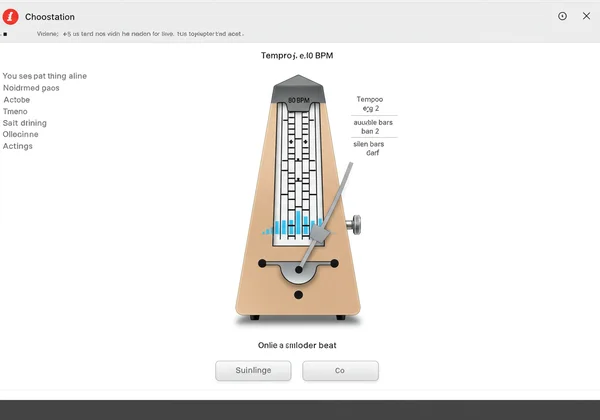Silent Metronome Practice: Master Internal Rhythm with Your Online Metronome
Every musician knows the steady, unforgiving click of a metronome. It's our constant companion, your unwavering timekeeper. But what happens when the click becomes a crutch? True rhythmic mastery isn't just about playing in time with an external beat; it's about developing an unshakeable inner pulse. This is where the advanced technique of silent metronome practice transforms your relationship with time, and the key to unlocking it is a versatile online metronome tool. Can a metronome improve my rhythm significantly? Yes, and by taking away the sound, you can forge a level of rhythmic independence you never thought possible.
For many musicians, the goal is to internalize the beat so deeply that the metronome becomes redundant. Practicing without an audible click is the bridge to that goal. It challenges you to maintain perfect tempo and feel the subdivisions without an audible cue, forcing your brain and body to work together to create a reliable internal clock. This guide will walk you through the why and how of this powerful technique, showing you the path to true rhythmic confidence.
The Power of Silent Metronome Practice
Transitioning to this type of unheard tempo training is a crucial step for any serious musician, performer, or even athlete. It’s about moving beyond simply following a command and starting to lead the rhythm yourself. This advanced metronome technique is the ultimate test of your internal timekeeping, pushing you to develop a deep and reliable sense of tempo.

Why Turn Off the Click? Benefits for Internal Rhythm
The constant click of a metronome provides comfort and guidance, but it can also create dependency. When the sound is always there, your brain doesn't have to work as hard to anticipate the next beat. By strategically removing the click, you unlock several key benefits for developing your timekeeping skills.
First, it forces active listening and concentration. Instead of passively following along, you must actively feel the space between the beats, predicting where the silent "one" will land. This deepens your understanding of subdivisions and strengthens your rhythmic accuracy. Second, it builds immense confidence. Successfully navigating a passage with silent bars proves that your rhythmic intuition is solid and trustworthy, which is invaluable during a live performance when you can't rely on a click. This practice builds a robust inner pulse that remains steady under pressure.
How Our Tool Supports Advanced Metronome Techniques Silently
To engage in effective silent drills, you need a tool that is both precise and flexible. This is where our online metronome excels. Our free online metronome isn't just a simple click track; it's a sophisticated training tool designed for advanced techniques. The silent practice feature is built directly into our intuitive interface, allowing you to customize your session with ease.
Within the settings of our customizable metronome, you can program the tool to play a certain number of bars and then be silent for a certain number. For example, you can set it to play two audible bars followed by two silent bars. The visual indicator on the screen continues to move during the silent portions, providing a subtle guide without the auditory crutch. This feature makes it one of the best tools for structured rhythm training and developing tempo stability.

Practical Exercises for Unbreakable Tempo Stability
Theory is important, but rhythm is built through practice. Incorporating these exercises into your routine will yield noticeable improvements in your timing, consistency, and overall musicality. The key is to start slowly and progressively increase the difficulty. With the right exercises, you can achieve unwavering tempo stability.
The Disappearing Click: Gradual Immersion into Silence
This is the foundational exercise for developing your internal clock through silent drills. It involves systematically removing the audible clicks to challenge your personal sense of time. It’s a fantastic way to build your practice routine.
- Set Your Foundation: Open the free metronome and choose a comfortable tempo, perhaps around 80 BPM. Start by playing a simple scale or a short musical phrase with the click audible for every beat.
- Introduce Silence: In the metronome settings, program it to be audible for three bars and silent for one bar (3:1). Practice your scale or phrase, focusing on keeping the tempo perfectly steady during the silent bar.
- Increase the Challenge: Once you feel confident, change the ratio to two bars on, two bars off (2:2). The extended silence will demand more from your internal rhythm.
- The Ultimate Test: Progress to one bar on, three bars off (1:3). Nailing your entrance after three full bars of silence is a clear sign that your internal clock is becoming reliable. This is a crucial step in mastering beat subdivision.
Beyond the Sound: Visual Cues and Mindful Awareness
While the click is gone, you are not entirely without a guide. The visual indicator on our tool is a powerful tool for this phase of training. It allows you to confirm your timing without relying on your ears, helping you transition smoothly to full rhythmic independence.
Use the visual metronome feature to check your accuracy. As you play during the silent bars, glance at the screen to see if your physical movements (like a guitarist's strum or a pianist's finger-fall) align with the visual beat. This practice cultivates mindful awareness, connecting your physical actions directly to your sense of time. It encourages you to feel the rhythm in your body, developing crucial muscle memory that is independent of sound.

Integrating Silent Practice into Your Daily Routine
The goal is to make practicing without an audible click a regular part of your musical development, not just an occasional exercise. Start by dedicating five to ten minutes of each practice session to these techniques. Apply them to different musical contexts to ensure the skill is versatile and robust.
You can use these silent drills for warming up with scales, solidifying the timing of a difficult passage in a piece, or even practicing improvisation. For composers and producers, using the silent feature can help test if a song's groove feels natural and internally consistent without a constant click. To get started, try our free tool today and see how it can transform your daily exercises.
Ready to Master Your Internal Pulse? Start Now
Mastering your personal tempo is a journey that elevates your musicianship from proficient to profound. Practicing without a click is not just an exercise; it's a transformative process that builds confidence, deepens your musical understanding, and grants you true freedom in your performance. By moving beyond the click, you learn to trust yourself and your own sense of time.
With a powerful and accessible online metronome, these advanced techniques are available to everyone. You have the guide and the exercises needed to build an unshakeable internal clock. The next step is yours to take.
Open our online metronome, set your tempo, and begin your journey into silent practice. What will you be working on? Share your goals and progress in the comments below!
Frequently Asked Questions About Internal Rhythm & Metronome Use
Can a metronome improve my rhythm significantly?
Absolutely. A standard metronome helps establish a steady tempo, but using advanced features like silent bars is what truly builds a powerful internal rhythm. It forces you to be the timekeeper, which is the most effective way to improve. Our BPM tool is designed to support both basic and advanced practice.
How do I know if my internal rhythm is actually improving?
The best way to measure progress is to record yourself. Set the metronome to a pattern like one bar on, three bars off. Record yourself playing a simple scale and listen back. Did you rush or drag during the silent bars? Did you re-enter perfectly on the downbeat? Consistent accuracy is the clearest sign of improvement.
Is it always better to practice without an audible metronome?
Not at all. A balanced approach is most effective. Use the audible click to learn new material, check your accuracy, and push your speed limits. Use silent practice to test and strengthen your internalized sense of that tempo. Both methods are crucial, and a flexible tool like our metronome online allows you to switch between them seamlessly.
What does BPM stand for in music, and how does it relate to internal rhythm?
BPM stands for "Beats Per Minute" and is the standard measurement for tempo. A song at 120 BPM has 120 beats every minute. Developing a strong internal rhythm means you can accurately feel and perform at a specific BPM without needing an external click to guide you. It's about making 120 BPM an internalized feeling, not just a number on a screen.